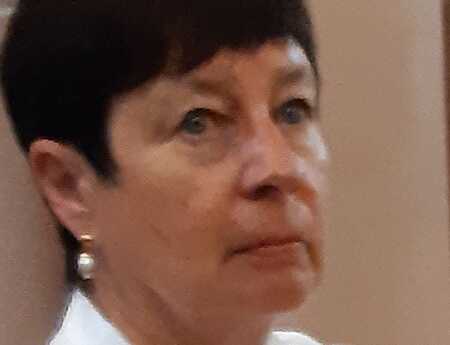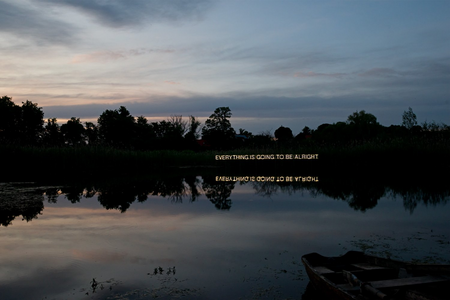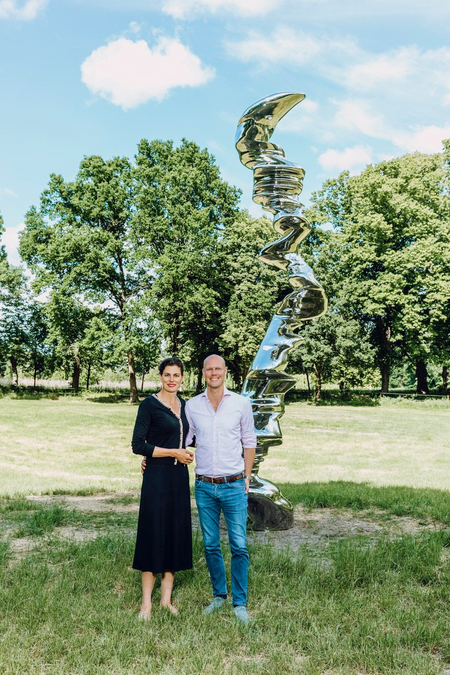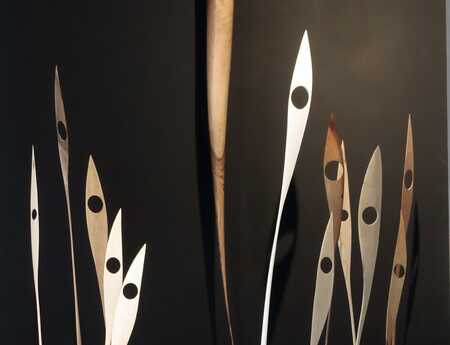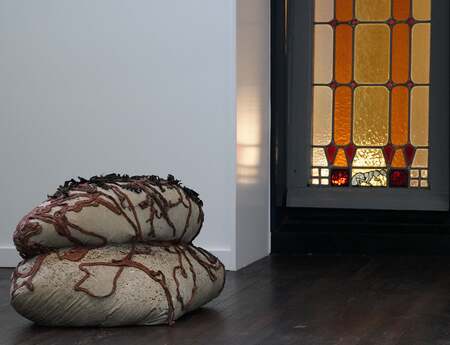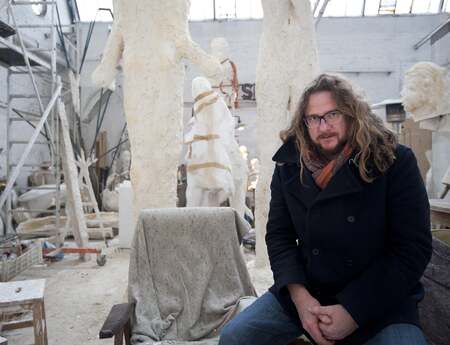Everything is going to be alright
Umgeben von Feldern, Gräben und Wäldern des Oberhavellandes liegt das barocke Schloss Schwante 25 km nordwestlich von Berlin. Hier schufen Loretta Würtenberger und Daniel Tümpel einen lebendigen Ort für Kunst, Natur und Genuss. Ursula Karpowitsch sprach mit ihnen über das Konzept und die Entstehung eines außergewöhnlichen Skulpturenparks.
Wie haben Sie die Bildhauerinnen und Bildhauer ausgesucht, die Sie im Skulpturenpark Schwante ausstellen wollten? Kamen diese auf Sie zu, war es irgendwann ein Selbstläufer oder wie muss man sich das vorstellen?
Daniel Tümpel (DT): Im Skulpturenpark gehen wir der Frage nach, wie Skulptur und Natur miteinander räsonieren. Wie haben Bildhauer*innen seit Hans Arp bis heute über Natur nachgedacht, sich zur Natur verhalten, Natur zum Bestandteil ihres Schaffens gemacht? Entsprechend haben wir die Künstler*innen ausgesucht, die wir zeigen. Zum Beispiel Toshihiko Mitsuja, der Blumenfelder aus Aluminium schafft, oder Tony Cragg, dessen biomorphe Formen an natürliche Formen erinnern und dennoch ganz klar ein Artefakt sind. Dann gibt es Künstler*innen, wie Björn Dahlem, die sich konzeptionell mit den Phänomenen der Natur auseinandersetzen.

Es spielt sicher für die Künstler*innen eine große Rolle, dass sie sich aussuchen können, wo sie ihre Skulpturen aufstellen wollen?
DT: Die Künstler*innen haben ein tolles Gespür dafür, wie die Interaktion mit der Natur stattfindet und wie das Umfeld aussehen muss, damit sich die Arbeit optimal entfaltet. Ein Beispiel ist die Arbeit von Jehudith Sasportas: sie hat diese unter den traumhaften Trauerweiden platziert und verlangte, dass die Trauerweiden auf eine Höhe von einem Meter geschnitten werden, das Gras so und so lang sein durfte und das passte dann auch perfekt. Oder bei der Arbeit von Dan Graham. Hier kamen extra seine Mitarbeiter*innen rüber geflogen und haben dann über FaceTime mit dem Künstler den richtigen Platz ausgesucht. Schließlich hat sich einer hingestellt und wurde Meter für Meter auf dem Grundstück dirigiert, hierhin und dorthin, bis es hieß „hier!“, da sollte die Arbeit hin. Und es passte wunderbar.
Man hat ja unglaubliche Möglichkeiten. Es gibt sogar Wasser. Noch ein Pluspunkt mehr.
DT: Martin Creeds Arbeit Everything is going to be alright
So wird man empfangen. Das ist großartig. Und gerade jetzt hat man das Gefühl, ja, hoffentlich! Das ist der Optimismus schlechthin.
DT: Wir haben uns entschieden, dass wir die Arbeit gedanklich mit einem Ausrufezeichen und nicht mit einem Fragezeichen versehen, weil das ein positiver Blick in die Zukunft ist.
Sie sind auch Arbeitgeber. Wie viele Leute haben letztes Jahr für Sie gearbeitet?
DT: Das war ein stattliches Team von zwanzig Mitarbeiter*innen: Köche und Köchinnen, Servicepersonal, die Mitarbeiter*innen, die die Führungen gemacht haben, Gärtner*innen. Wir hatten pro Wochenende viele, viele Besuchende und die mussten dann entsprechend versorgt werden, einerseits mit Essen, andererseits im Hofladen.
Es gibt noch einen anderen Aspekt, der uns sehr am Herzen liegt. Das Schloss Schwante war immer Zentrum eines Betriebes, früher war dies ein landwirtschaftlicher Betrieb im Brandenburger Land. Mit dem Skulpturenpark haben wir eine Form gefunden, die uns entspricht und zudem zeitgenössisch ist und in einer ergänzenden Art und Weise in Verbindung zu bringen ist.
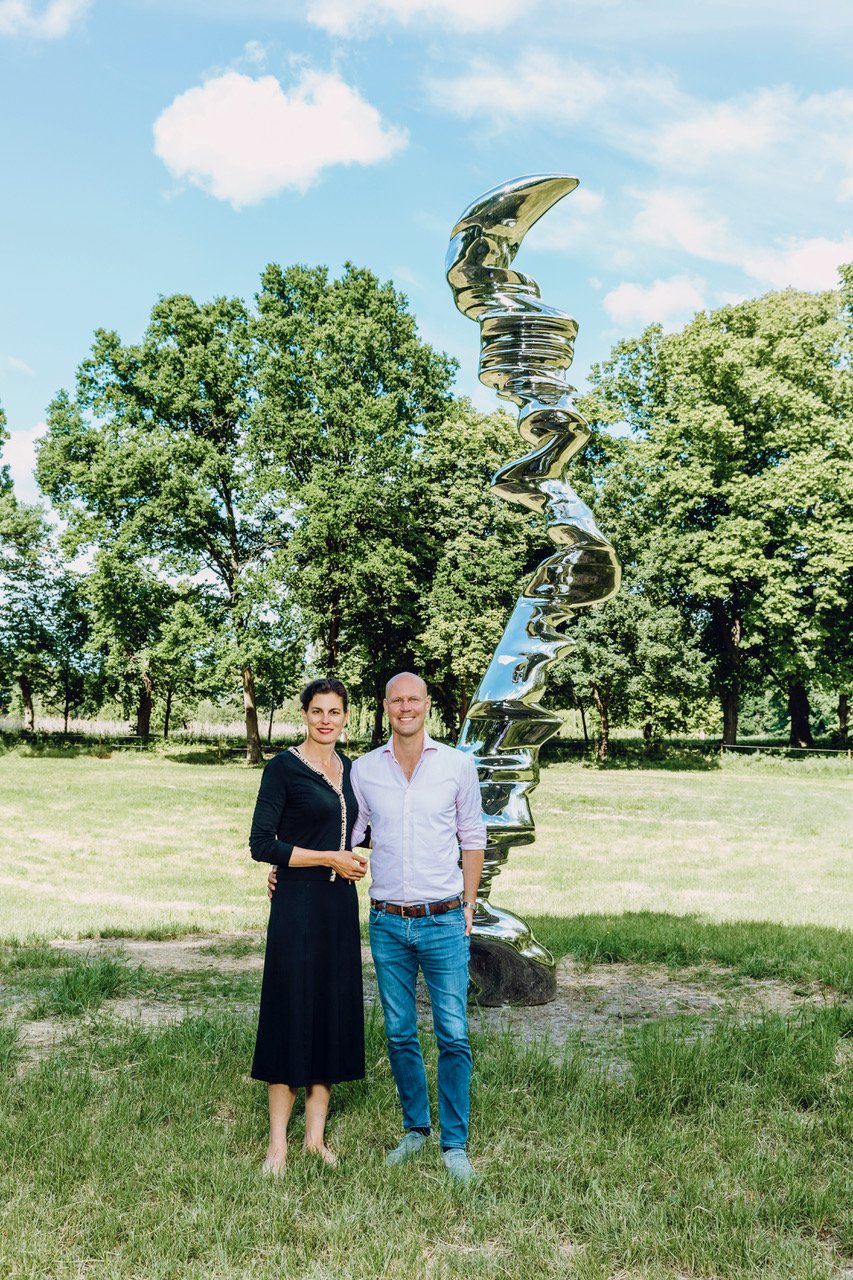
Wie wurden Sie in Schwante willkommen geheißen?
Loretta Würtenberger (LW): Es ist uns wichtig unseren Beitrag mit dem zu verbinden, was hier schon immer Bestand hatte. Deshalb auch das Programm für den Sommer, das Apfelfest, das Dorffest, dass wir den Hofladen machen, dass das Brücken setzt, dass sich die Dinge ganz wunderbar natürlich miteinander anfühlen. Uns geht es auch darum, dass die Schwantener hier abends ein Bier trinken können, völlig unabhängig davon, ob sie den Skulpturenpark gut finden oder nicht. Dass wir uns in die vorgefundenen Strukturen einfügen. Je länger wir hier sind, desto mehr spüren wir, wie viel bürgerliches Engagement in der Gemeinde schon da ist, wie viel unternehmerisches Engagement es hier gibt. Wir sind nur eines von vielen hiesigen Unternehmen. Es ist uns wichtig, uns selbst zurückzunehmen und uns da einzugliedern. Wir wollen nicht aufeinanderprallen, wir wollen uns wohlfühlen.
Ich vermute mal, dass die Bildhauerinnen und Bildhauer damit sehr zufrieden sind, dass es im letzten Jahr viele tausende Besucher*innen gab? Wie ist da die Resonanz?
LW: Sehr gut. Wenn ich an Katja Strunz denke mit ihrer Arbeit, die überall abgebildet war. Und aus diesem großen Medienecho heraus entwickelten sich Folgegeschichten. Wenn die Künstler*innen davon profitieren, dann freut uns das am meisten.
DT: Und für die Galerien ist es auch toll. Manche sind mit den Sammler*innen hierhergekommen und haben gesagt, guck mal, so sieht das draußen aus. Passt doch auch in deinen Garten (lacht)!

Wie sieht die Planung aus, wie soll es in Zukunft weitergehen?
LW: Es muss lebendig bleiben. Wir dachten am Anfang, wir machen alle zwei Jahre alles neu. Dann kamen nach einem Jahr einige Künstler*innen und sagten, es ist so schön hier. Hättet Ihr Interesse, dass es zehn Jahre stehen bleibt? So zum Beispiel die Arbeit von Carsten Nicolai. Dann haben wir auch viel mit den Besucher*innen gesprochen. Wir kennen das selbst. Wenn ich nach Louisiana [Dänemark] fahre, dann wäre ich traurig, wenn da immer alles neu wäre. Ich kehre auch in Museen zu alten Freunden zurück. Ich will was Neues sehen, aber ich finde es wahnsinnig schön, Arbeiten wieder besuchen zu können. Also haben wir beschlossen, dass es jedes Jahr etwas Neues geben, aber gleichwohl etwas bereits Vorhandenes bleiben soll, so dass es auch in dieser Beziehung organisch ist. Wir nennen es ein ‚atmendes‘ Konzept.
Titelbild: Martin Creed: Work No. 1086, Everything is going to be alright. 2011, Neonglasarbeit, 44 x 1250 cm, Unikat. © Martin Creed, courtesy Hauser & Wirth

